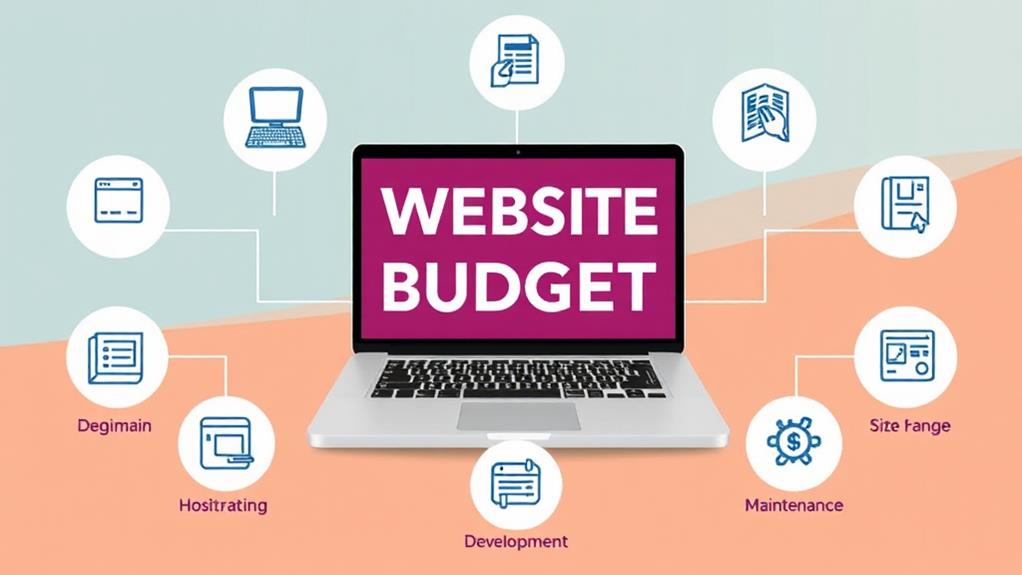Determining an appropriate budget for a website is an essential step in its development, yet the question remains: what constitutes a good budget? Factors such as functionality, design intricacy, and scalability all play significant roles in budget considerations. The realm of website costs is vast, ranging from modest sums to substantial investments. As we investigate the nuances of budgeting for a website, we will uncover key understandings that can guide your decision-making process and lead to a successful online presence.
Key Takeaways
- Consider website type and complexity for budget planning.
- Research average costs for website development.
- Factor in ongoing maintenance and hidden costs.
- Set aside funds for scalability and unforeseen expenses.
- Prioritize design, content quality, and SEO efforts for optimal results.
Factors Influencing Website Costs
Factors influencing website costs play an essential role in determining the financial investment required for a successful online presence.
Design choices, content strategy, target audience, platform selection, hosting options, branding elements, marketing integration, and functionality needs all contribute to the overall cost of a website.
Design choices involve the layout, graphics, and visual elements of the site, impacting both the aesthetic appeal and user experience. A well-thought-out content strategy influences the amount and type of content needed, affecting costs related to copywriting, photography, and video production.
Comprehending the target audience helps tailor the website to meet their preferences and needs, potentially requiring additional features or customization.
The platform selection, whether a custom-built site or a template-based solution, can greatly impact costs. Hosting options, including shared, VPS, or dedicated hosting, also play a role in determining the budget.
Incorporating branding elements consistently throughout the site and integrating marketing strategies further add to the overall expenses.
Types of Websites and Their Costs
When considering the costs associated with different types of websites, it is essential to factor in the varying levels of difficulty each type presents.
The difficulty of a website can greatly impact the overall cost, as more elaborate features and functionalities often require more resources and knowledge to develop and maintain.
Comprehending the factors influencing costs, such as design elaborateness, e-commerce capabilities, and interactive elements, is vital for determining an appropriate budget for a website project.
Website Complexity Levels
Different types of websites vary in intricacy levels, resulting in a wide range of costs associated with their development. The intricacy of a website is often determined by the inclusion of advanced features, custom designs, and the overall user experience it provides. Below is a breakdown of different website intricacy levels and their associated costs:
| Intricacy Level | Description | Cost Range |
|---|---|---|
| Basic Websites | Simple sites with static content and minimal interactive elements | $500 – $2,000 |
| E-commerce Sites | Websites with online stores, payment gateways, and product management | $2,000 – $10,000 |
| Custom Web Apps | Tailored web applications with intricate functionalities and user interfaces | $10,000 – $50,000 |
| Enterprise Websites | Large-scale websites for corporations with multiple integrations | $50,000 – $100,000+ |
| Dynamic Platforms | Highly interactive sites with real-time updates, AI integration, etc. | $100,000+ |
Understanding the intricacy level of the website you need will help in determining an appropriate budget for its development.
Factors Affecting Costs
Boasting a broad spectrum of intricacy levels, websites come in various forms, each with distinct features that directly impact the costs associated with their development. The type of website, its target audience, and website goals play a significant role in determining the overall cost.
Simple websites, such as basic informational sites or blogs, are generally more affordable to develop due to their straightforward design and content structure. On the other hand, e-commerce websites, which involve complex features like payment gateways, inventory management, and product databases, tend to be more costly.
Corporate websites that require custom functionalities, integration with other systems, or advanced security measures also fall on the higher end of the cost spectrum. Comprehending the intended purpose of the website and the specific needs of the target audience is essential in accurately estimating the budget required for its development.
DIY vs. Professional Website Costs
For individuals or businesses looking to establish their online presence, the decision between creating a website themselves (DIY) or hiring a professional service can greatly impact their budget.
DIY advantages include cost savings, design flexibility, and direct client collaboration. On the other hand, professional benefits include proficiency, time savings, and long-term maintenance responsibility.
When comparing costs, DIY projects generally require less financial investment upfront but may necessitate more time investment and skill assessment. Professional services often come with higher initial costs but can lead to long-term savings and a polished final product.
Additionally, the impact on branding should be considered, as a professionally designed website can improve credibility and user experience.
Ultimately, the choice between DIY and professional website creation depends on factors such as budget, time availability, technical skills, and the desired level of customization.
Hidden Costs to Consider
When budgeting for a website, it is essential to take into account potential hidden costs that may arise.
Unforeseen maintenance expenses can quickly add up, impacting your overall budget.
Additionally, additional plugin costs for improved functionality can sometimes be necessary but often overlooked in initial budget calculations.
Unforeseen Maintenance Expenses
Website maintenance costs can often catch businesses off guard with unforeseen expenses that are not initially factored into the budget. Unexpected repairs and ongoing updates are common culprits that can considerably impact a website's financial health. To better understand these unforeseen maintenance expenses, let's explore a breakdown of potential hidden costs:
| Maintenance Expense | Description | Estimated Cost |
|---|---|---|
| Security Updates | Vital for protecting against cyber threats and vulnerabilities. | $500 – $1,000 annually |
| Hosting Upgrades | As traffic grows, higher hosting plans may be required for peak performance. | $20 – $50 per month |
| Backup Solutions | Regular backups guarantee data security and can be essential in the event of data loss. | $100 – $300 per year |
Additional Plugin Costs
Plugins play a vital role in improving a website's functionality by offering additional features and customization options. While many plugins are free to use, some may come with a price tag attached.
When considering additional plugin costs, it's important to factor in plugin pricing strategies to guarantee they align with your budget. Some plugins may have a one-time purchase fee, while others operate on a subscription basis, requiring ongoing payments. It's important to assess whether the added functionality justifies the cost of the plugin.
When evaluating additional plugin costs, consider significant plugin recommendations that can benefit your website without breaking the bank. Prioritize plugins that improve security, enhance site speed, optimize SEO, or streamline user experience.
Setting Realistic Budget Expectations
Establishing realistic budget expectations is an important step in the process of creating a successful website. Budget planning and cost estimation are vital components of this phase.
When setting budget expectations for a website, it's important to take into account various factors such as the intricacy of the site, desired features, ongoing maintenance costs, and any additional services required.
To begin, conduct thorough research to understand the average costs associated with website development, design, hosting, and maintenance. This will provide a baseline for your budget planning.
Reflect on the scalability of your website and factor in potential future expenses for upgrades or expansions.
Moreover, it's advisable to account for unexpected costs that may arise during the development process. Setting aside a contingency fund can help mitigate any financial surprises.
Examples of Website Budget Breakdowns
When determining the financial allocation for a website project, breaking down the budget into specific categories is essential for effective cost management.
Website budget breakdowns typically include costs for website features, design elements, development, maintenance, and marketing. For example, allocating around 30% of the budget to website features such as e-commerce functionality, contact forms, and galleries guarantees a robust and user-friendly site.
Design elements like custom graphics, responsive design, and typography may consume about 20% of the budget, contributing to the overall aesthetics and user experience.
Development costs, including coding, programming, and database setup, often require the largest portion, approximately 40% of the budget, ensuring the website functions smoothly and efficiently.
Maintenance costs, which involve updates, security measures, and backups, should account for about 5-10% of the budget to keep the site running effectively.
Finally, allocating 10% of the budget to marketing efforts like SEO, social media, and online advertising helps drive traffic and improve visibility.
Properly distributing the budget across these categories is key to a successful website project.
Tips for Maximizing Your Website Budget
To effectively maximize your website budget, prioritizing key areas of investment is vital. When it comes to website design, allocate a notable portion of your budget to guarantee a visually appealing and user-friendly site. A well-designed website not only attracts visitors but also improves user experience, leading to higher engagement and conversions.
Another important aspect to focus your budget on is developing a robust content strategy. Quality content is essential for driving traffic to your site and keeping visitors engaged. Investing in professional copywriting, photography, and video production can boost your content and set your website apart from competitors.
Additionally, consider allocating funds for search engine optimization (SEO) to improve your website's visibility on search engines. SEO optimization can increase organic traffic and help you reach a wider audience.
Frequently Asked Questions
How Can I Ensure My Website Stays Within Budget?
To guarantee your website remains within budget, implement cost-saving strategies such as utilizing open-source platforms, outsourcing tasks to freelancers instead of hiring full-time staff, and regularly tracking expenses.
Adopting a proactive approach to budget tracking can help identify potential overspending early on, allowing for adjustments to be made promptly.
Are Ongoing Maintenance Costs Included in the Budget?
When considering the costs of a website, ongoing maintenance services are a critical component often overlooked in initial budget calculations.
These services include regular updates, security measures, and troubleshooting to guarantee peak performance.
Including maintenance costs in your budget is essential for accurate cost analysis and long-term sustainability.
What Are the Risks of Underestimating Website Costs?
Underestimating website costs can lead to various risks, including unexpected hidden expenses that may arise during development or post-launch.
Failing to account for these can disrupt project timelines and strain financial resources. Additionally, underestimation can have long-term consequences by compromising the website's functionality, security, and scalability.
It is essential to conduct thorough research, consider all potential costs, and allocate a sufficient budget to mitigate these risks.
Can I Negotiate Pricing With Website Developers?
In the domain of website development, negotiating pricing with developers can be a strategic move to optimize cost-efficiency.
By exploring various pricing strategies and comprehending the developer's flexibility, clients can potentially reach mutually beneficial agreements that align with their budget constraints.
Effective communication, clear expectations, and a willingness to compromise can promote productive discussions that lead to favorable outcomes for both parties involved in the pricing negotiation process.
What Are Common Factors That Lead to Budget Overruns?
Factors that often lead to budget overruns in website development projects include scope creep and feature inflation.
Scope creep refers to the gradual expansion of project requirements beyond the original plan, while feature inflation involves the addition of unnecessary or overly complex features.
These issues can result in increased development time, resources, and costs.
It is essential for project managers to closely monitor and manage project scope to prevent budget overruns.
Conclusion
In conclusion, determining a suitable budget for a website involves considering various factors such as intricacy, purpose, and ongoing maintenance. Like a well-oiled machine, a well-rounded budget guarantees smooth operation and future growth. By comprehending the different types of websites and hidden costs involved, businesses can make informed decisions to maximize their website budget effectively.





